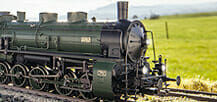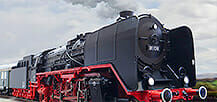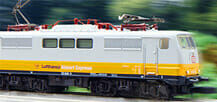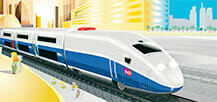Heavy Diesel Locomotive.
Prototype: German Federal Railroad (DB) class V 188 double unit diesel electric locomotive. Version in a crimson red paint scheme. The locomotive looks as it did at the beginning of the Sixties.
Most Important Facts
| Article No. | 37283 |
|---|---|
| Gauge / Design type | H0 / 1:87 |
| Era | III |
| Kind | Diesel Locomotives |
Check with your local dealer Find Dealer
Highlights
- Double locomotive with 2 motors.
- Realistic diesel locomotive sound.
-
Product description
Model: The locomotive has an mfx digital decoder and extensive sound functions. It also has controlled high-efficiency propulsion. Both locomotives have a motor. 4 axles powered. Traction tires. The triple headlights and the dual red marker lights change over with the direction of travel, will work in conventional operation, and can be controlled digitally. The headlights are maintenance-free, warm white LEDs, and the marker lights are maintenance-free red LEDs. There is a special close coupling with a guide mechanism between the locomotives.
Length over the buffers 25.8 cm / 10-1/8".Find more Märklin explanation videos on our YouTube Channel
Spare parts for our articles can be found here in our spare parts search.
One-time series.
-
Publications
- New items brochure 2010 - Product programme 2010/2011
-
Prototype information
The class V 188 double locomotives (from 1968 on: class 288) enriched the motive power roster of the German Federal Railroad as exotic diesel electric units with a remarkable past. In 1939, Krupp had a contract to build two super cannons, which were the largest artillery cannons ever built: the railroad cannons "Dora" and "Schwerer Gustav 2" ("Heavy Gustaf 2") with an 80 cm / 31-1/2" caliber and a range of up to 47 km / 29 miles. In 1941, this contract was supplemented by another, somewhat smaller cannon with the name "Langer Gustav" ("Long Gustav"). Three trains were required to bring a giant cannon with a weight of around 1,350 metric tons to its emplacement. The Germany army ordered six double locomotives with diesel electric power transmission from Krupp to haul the train and to provide electrical power for setup and use of the immense cannons. Each type D 311 locomotive unit consisted of two close-coupled halves with rigid frames and four wheel sets. Each half had a 940 hp PS starker, turbo-charged six-cylinder series motor from MAN. This unit drove a DC generator, which in turn powered the four traction motors suspended from the axles. The electrical equipment for the locomotives came from the Siemens-Schuckert plant in Berlin. Engineer's cabs were only present on the outer ends of the "Twin Locomotives". The first two double locomotives, road nos. D 311.01A/B and 02A/B, were delivered in October of 1941; two more followed in August of 1942. It was not possible to build the last two unit as well as the third cannon, since Krupp's production facilities had been largely destroyed by air attacks. The first, totally oversized cannon built, "Dora" was only used once on the front at Sevastopol and was blown up in 1945 along with its sister cannon. Three of the four double locomotives did survive the war, and two of them were overhauled at Krauss-Maffei between 1948 and 1951. The DB assigned them the road numbers V 188 001a/b (former D 311.03A/B), V 188 002a/b (former D 133.04A/B), and V 188 003a/b (former D 311.02A/B). The last unit mentioned was not overhauled but was kept a long time for spare parts. The two overhauled locomotives were initially assigned to the Aschaffenburg District and were used there for pusher service on the Spessart grade between Laufach and Heigenbrücken. Starting in 1953 they were used somewhat less successfully to haul freight trains to Schweinfurt, Bamberg, and Dillenburg. The old MAN motors increasingly caused problems. The two locomotives were therefore equipped with new 1,000 hp (later 1,100 hp) Maybach motors by 1957/58 as well as new gear drives from Gmeinder. After that they worked excellently and were used by the end of 1958 in the Aschaffenburg District, then in the Gemünden District, and from 1967/68 on in the Bamberg District in heavy freight service. After sustaining great damages the two war veterans had to be retired on September 25, 1969 (288 001) and on June 15, 1972 (288 002) as part of the general program to rationalize the motive power. Later they were scrapped.
-
Digital Functions
Control Unit Mobile Station Mobile Station 2 Central Station 1/2 Central Station 3/2*
Mobile Station 2**Headlight(s) Diesel locomotive op. sounds Locomotive whistle Direct control Sound of squealing brakes off Headlight(s): Cab2 End Brake Compressor Headlight(s): Cab1 End * New features of the Central Station 2 (Part No. 60213, 60214 or 60215) with the software update 4.2
** New features of the Mobile Station 2 (Part No. 60657/66955) with the Software Update 3.55













